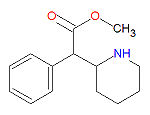Methylphenidate: Difference between revisions
imported>Richard Pettitt No edit summary |
mNo edit summary |
||
| (5 intermediate revisions by 3 users not shown) | |||
| Line 1: | Line 1: | ||
{{subpages}} | {{subpages}} | ||
{{Image|Methylphenidate structure.jpg|right|150px|Methylphenidate}} | |||
'''Methylphenidate''' is a stimulant drug commonly used in the treatment of [[attention-deficit hyperactivity disorder]], as well as [[narcolepsy]]. It gained widespread recognition under the trade name | '''Methylphenidate''' is a stimulant drug commonly used in the treatment of [[attention-deficit hyperactivity disorder]], as well as [[narcolepsy]]. It gained widespread recognition under the trade name Ritalin from controversy surrounding its use in the treatment of ADHD. | ||
== Effects == | == Effects == | ||
| Line 12: | Line 12: | ||
== Usage in ADHD == | == Usage in ADHD == | ||
Methylphenidate is used in the treatment of attention-deficit hyperactivity disorder to reduce locomotor activity, reduce impulsive behaviour, and improve attention. It improves working memory performance by local reduction in cerebral blood flow in the dorsolateral prefrontal cortex and posterior parietal cortex.<ref name="pmid10704519">{{cite journal |author=Mehta MA, Owen AM, Sahakian BJ, Mavaddat N, Pickard JD, Robbins TW |title=Methylphenidate enhances working memory by modulating discrete frontal and parietal lobe regions in the human brain |journal=J. Neurosci. |volume=20 |issue=6 |pages=RC65 |year=2000 |pmid=10704519 |doi=}}</ref> | Methylphenidate is used in the treatment of attention-deficit hyperactivity disorder to reduce locomotor activity, reduce impulsive behaviour, and improve attention. It improves working memory performance by local reduction in cerebral blood flow in the dorsolateral prefrontal cortex and posterior parietal cortex.<ref name="pmid10704519">{{cite journal |author=Mehta MA, Owen AM, Sahakian BJ, Mavaddat N, Pickard JD, Robbins TW |title=Methylphenidate enhances working memory by modulating discrete frontal and parietal lobe regions in the human brain |journal=J. Neurosci. |volume=20 |issue=6 |pages=RC65 |year=2000 |pmid=10704519 |doi=}}</ref> While the majority of treatment and research is on childhood ADHD, methylphenidate is similarly effective in the treatment of adult ADHD.<ref name="pmid14709943">{{cite journal |author=Faraone SV, Spencer T, Aleardi M, Pagano C, Biederman J |title=Meta-analysis of the efficacy of methylphenidate for treating adult attention-deficit/hyperactivity disorder |journal=J Clin Psychopharmacol |volume=24 |issue=1 |pages=24–9 |year=2004 |pmid=14709943 |doi=10.1097/01.jcp.0000108984.11879.95}}</ref> | ||
The common usage of methylphenidate to treat children with ADHD has prompted concerns that using stimulant medication | The common usage of methylphenidate to treat children with ADHD has prompted concerns that using stimulant medication during a period of development will adversly effect physical and neural growth, as well as predispose them to later substance abuse. Two recent meta-analyses found no evidence for increased future drug use,<ref name="pmid12509561">{{cite journal |author=Barkley RA, Fischer M, Smallish L, Fletcher K |title=Does the treatment of attention-deficit/hyperactivity disorder with stimulants contribute to drug use/abuse? A 13-year prospective study |journal=Pediatrics |volume=111 |issue=1 |pages=97–109 |year=2003 |pmid=12509561 |doi=}}</ref> and even suggest childhood stimulant therapy may reduce the risk of later substance disorders.<ref name="pmid12509574">{{cite journal |author=Wilens TE, Faraone SV, Biederman J, Gunawardene S |title=Does stimulant therapy of attention-deficit/hyperactivity disorder beget later substance abuse? A meta-analytic review of the literature |journal=Pediatrics |volume=111 |issue=1 |pages=179–85 |year=2003 |pmid=12509574 |doi=}}</ref> | ||
== References == | == References == | ||
| Line 21: | Line 21: | ||
== External Links == | == External Links == | ||
{{CZMed}}[[Category:Suggestion Bot Tag]] | |||
Latest revision as of 12:01, 18 September 2024
Methylphenidate is a stimulant drug commonly used in the treatment of attention-deficit hyperactivity disorder, as well as narcolepsy. It gained widespread recognition under the trade name Ritalin from controversy surrounding its use in the treatment of ADHD.
Effects
Mechanism of action
Methylphenidate is an indirect catacholamine agonist by blocking the reuptake of dopamine and norepinephrine into the pre-synaptic cell. This increase of neurotransmitters in the synaptic cleft leads to increased neural activity in the striatum.
Usage in ADHD
Methylphenidate is used in the treatment of attention-deficit hyperactivity disorder to reduce locomotor activity, reduce impulsive behaviour, and improve attention. It improves working memory performance by local reduction in cerebral blood flow in the dorsolateral prefrontal cortex and posterior parietal cortex.[1] While the majority of treatment and research is on childhood ADHD, methylphenidate is similarly effective in the treatment of adult ADHD.[2]
The common usage of methylphenidate to treat children with ADHD has prompted concerns that using stimulant medication during a period of development will adversly effect physical and neural growth, as well as predispose them to later substance abuse. Two recent meta-analyses found no evidence for increased future drug use,[3] and even suggest childhood stimulant therapy may reduce the risk of later substance disorders.[4]
References
- ↑ Mehta MA, Owen AM, Sahakian BJ, Mavaddat N, Pickard JD, Robbins TW (2000). "Methylphenidate enhances working memory by modulating discrete frontal and parietal lobe regions in the human brain". J. Neurosci. 20 (6): RC65. PMID 10704519. [e]
- ↑ Faraone SV, Spencer T, Aleardi M, Pagano C, Biederman J (2004). "Meta-analysis of the efficacy of methylphenidate for treating adult attention-deficit/hyperactivity disorder". J Clin Psychopharmacol 24 (1): 24–9. DOI:10.1097/01.jcp.0000108984.11879.95. PMID 14709943. Research Blogging.
- ↑ Barkley RA, Fischer M, Smallish L, Fletcher K (2003). "Does the treatment of attention-deficit/hyperactivity disorder with stimulants contribute to drug use/abuse? A 13-year prospective study". Pediatrics 111 (1): 97–109. PMID 12509561. [e]
- ↑ Wilens TE, Faraone SV, Biederman J, Gunawardene S (2003). "Does stimulant therapy of attention-deficit/hyperactivity disorder beget later substance abuse? A meta-analytic review of the literature". Pediatrics 111 (1): 179–85. PMID 12509574. [e]
External Links
The most up-to-date information about Methylphenidate and other drugs can be found at the following sites.
- Methylphenidate - FDA approved drug information (drug label) from DailyMed (U.S. National Library of Medicine).
- Methylphenidate - Drug information for consumers from MedlinePlus (U.S. National Library of Medicine).
- Methylphenidate - Detailed information from DrugBank.
